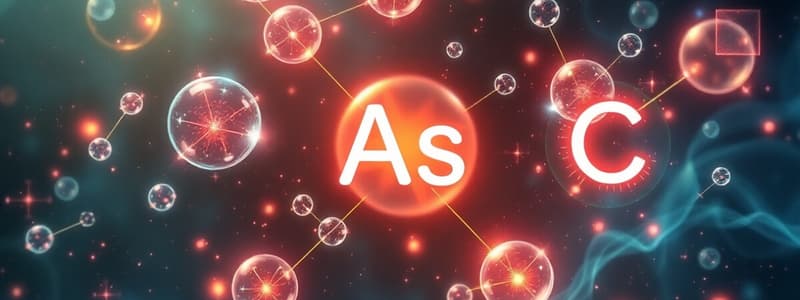Podcast
Questions and Answers
Which of the following polyatomic ions has a +1 charge?
Which of the following polyatomic ions has a +1 charge?
- Phosphate
- Nitrate
- Hydroxide
- Ammonium (correct)
What is the chemical formula for the sulfite ion?
What is the chemical formula for the sulfite ion?
- HSO3
- SO4
- HSO4
- SO3 (correct)
Which of the following pairs has the same charge?
Which of the following pairs has the same charge?
- Carbonate and Hydrogen Phosphate
- Nitrite and Permanganate (correct)
- Sulfate and Phosphate
- Nitrate and Sulfite
What is the valence of the dichromate ion?
What is the valence of the dichromate ion?
Which of the following polyatomic ions contains only one oxygen atom?
Which of the following polyatomic ions contains only one oxygen atom?
Which of the following chemical formulas represents the hydrogen phosphate ion?
Which of the following chemical formulas represents the hydrogen phosphate ion?
If a compound contains the chromate ion, what is the ion's charge?
If a compound contains the chromate ion, what is the ion's charge?
Which of the following polyatomic ions has the greatest number of oxygen atoms?
Which of the following polyatomic ions has the greatest number of oxygen atoms?
What is the chemical formula for the cyanide ion?
What is the chemical formula for the cyanide ion?
Which polyatomic ion is derived from carbonic acid (H2CO3) by removing two protons?
Which polyatomic ion is derived from carbonic acid (H2CO3) by removing two protons?
What is the name of the polyatomic ion with the formula MnO4?
What is the name of the polyatomic ion with the formula MnO4?
What is the difference in the number of oxygen atoms between chlorite and perchlorate?
What is the difference in the number of oxygen atoms between chlorite and perchlorate?
Which of the following ions is also known as hydrogen carbonate?
Which of the following ions is also known as hydrogen carbonate?
How many hydrogen atoms are present in the dihydrogen phosphate ion?
How many hydrogen atoms are present in the dihydrogen phosphate ion?
What is the chemical formula for the acetate ion?
What is the chemical formula for the acetate ion?
Which of the following polyatomic ions does NOT contain sulfur?
Which of the following polyatomic ions does NOT contain sulfur?
Which of the following represents the correct formula and charge for the peroxide ion?
Which of the following represents the correct formula and charge for the peroxide ion?
Which of the following polyatomic ions has a negative charge and contains nitrogen?
Which of the following polyatomic ions has a negative charge and contains nitrogen?
Which of the following is the correct formula for the bisulfate ion?
Which of the following is the correct formula for the bisulfate ion?
Flashcards
Ammonium (NH₄⁺)
Ammonium (NH₄⁺)
A polyatomic ion with the formula NH₄⁺ and a valence of +1.
Hydroxide (OH⁻)
Hydroxide (OH⁻)
A diatomic anion with the formula OH⁻ and a valence of -1.
Nitrate (NO₃⁻)
Nitrate (NO₃⁻)
A polyatomic ion with the formula NO₃⁻ and a valence of -1.
Nitrite (NO₂⁻)
Nitrite (NO₂⁻)
Signup and view all the flashcards
Cyanide (CN⁻)
Cyanide (CN⁻)
Signup and view all the flashcards
Thiocyanate (SCN⁻)
Thiocyanate (SCN⁻)
Signup and view all the flashcards
Hypochlorite (ClO⁻)
Hypochlorite (ClO⁻)
Signup and view all the flashcards
Chlorite (ClO₂⁻)
Chlorite (ClO₂⁻)
Signup and view all the flashcards
Chlorate (ClO₃⁻)
Chlorate (ClO₃⁻)
Signup and view all the flashcards
Perchlorate (ClO₄⁻)
Perchlorate (ClO₄⁻)
Signup and view all the flashcards
Acetate (C₂H₃O₂⁻)
Acetate (C₂H₃O₂⁻)
Signup and view all the flashcards
Bicarbonate (HCO₃⁻)
Bicarbonate (HCO₃⁻)
Signup and view all the flashcards
Bisulfite (HSO₃⁻)
Bisulfite (HSO₃⁻)
Signup and view all the flashcards
Bisulfate (HSO₄⁻)
Bisulfate (HSO₄⁻)
Signup and view all the flashcards
Permanganate (MnO₄⁻)
Permanganate (MnO₄⁻)
Signup and view all the flashcards
Dihydrogen phosphate (H₂PO₄⁻)
Dihydrogen phosphate (H₂PO₄⁻)
Signup and view all the flashcards
Sulfate (SO₄²⁻)
Sulfate (SO₄²⁻)
Signup and view all the flashcards
Sulfite (SO₃²⁻)
Sulfite (SO₃²⁻)
Signup and view all the flashcards
Carbonate (CO₃²⁻)
Carbonate (CO₃²⁻)
Signup and view all the flashcards
Phosphate (PO₄³⁻)
Phosphate (PO₄³⁻)
Signup and view all the flashcards
Study Notes
- Ammonium has the symbol NH4 and a valence of +1.
- Hydroxide has the symbol OH and a valence of -1.
- Nitrate has the symbol NO3 and a valence of -1.
- Nitrite has the symbol NO2 and a valence of -1.
- Cyanide has the symbol CN and a valence of -1.
- Thiocyanate has the symbol SCN and a valence of -1.
- Hypochlorite has the symbol ClO and a valence of -1.
- Chlorite has the symbol ClO2 and a valence of -1.
- Chlorate has the symbol ClO3 and a valence of -1.
- Perchlorate has the symbol ClO4 and a valence of -1.
- Acetate has the symbol C2H3O2 and a valence of -1.
- Bicarbonate (or Hydrogen carbonate) has the symbol HCO3 and a valence of -1.
- Bisulfite has the symbol HSO3 and a valence of -1.
- Bisulfate has the symbol HSO4 and a valence of -1.
- Permanganate has the symbol MnO4 and a valence of -1.
- Dihydrogen phosphate has the symbol H2PO4 and a valence of -1.
- Sulfate has the symbol SO4 and a valence of -2.
- Sulfite has the symbol SO3 and a valence of -2.
- Carbonate has the symbol CO3 and a valence of -2.
- Chromate has the symbol CrO4 and a valence of -2.
- Dichromate has the symbol Cr2O7 and a valence of -2.
- Hydrogen phosphate has the symbol HPO4 and a valence of -2.
- Peroxide has the symbol O2 and a valence of -2.
- Phosphate has the symbol PO4 and a valence of -3.
Studying That Suits You
Use AI to generate personalized quizzes and flashcards to suit your learning preferences.




